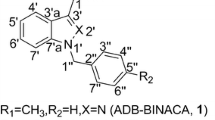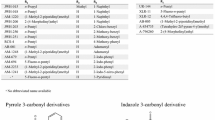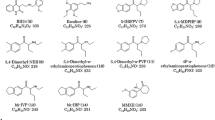Abstract
During our careful surveillance of unregulated drugs, we found five new compounds used as adulterants in herbal and drug-like products obtained via the Internet. These compounds were identified by liquid chromatography–mass spectrometry, gas chromatography–mass spectrometry, accurate mass spectrometry, and nuclear magnetic resonance spectroscopy. The first compound identified was a benzoylindole AM-694, which is 1-[(5-fluoropentyl)-1H-indol-3-yl]-(2-iodophenyl)methanone (1). The second compound was (4-methoxyphenyl)(1-pentyl-1H-indol-3-yl)methanone (2), which was also classified as a benzoylindole. The three other compounds were identified as naphthoylindoles JWH-210 (4-ethylnaphthalen-1-yl-(1-pentylindol-3-yl)methanone; 3), JWH-122 (4-methylnaphthalen-1-yl-(1-pentylindol-3-yl)methanone; 4), and JWH-019 (1-hexyl-3-(naphthalen-1-oyl)indole; 5). All compounds except compound 2 had been reported to be cannabinoid receptor agonists. For quantitation of the five compounds and previously reported compounds, each product was extracted with methanol under ultrasonication to prepare a test solution for analysis by liquid chromatography with ultraviolet detection. Each compound detected in 43 commercial products showed large variation in content ranging from 4.0 to 359 mg per pack.













Similar content being viewed by others
References
Uchiyama N, Kikura-Hanajiri R, Kawahara N, Haishima Y, Goda Y (2009) Identification of a cannabinoid analog as a new type of designer drug in a herbal product. Chem Pharm Bull 57:439–441
Uchiyama N, Kikura-Hanajiri R, Kawahara N, Goda Y (2009) Identification of a cannabimimetic indole as a designer drug in a herbal product. Forensic Toxicol 27:61–66
Kikura-Hanajiri R, Kawamura M, Maruyama T, Kitajima M, Takayama M, Goda Y (2009) Simultaneous analysis of mitragynine, 7-hydroxymitragynine, and other alkaloids in the psychotropic plant “kratom” (Mitragyna speciosa) by LC–ESI–MS. Forensic Toxicol 27:67–74
Uchiyama N, Kawamura M, Kikura-Hanajiri R, Goda Y (2011) Identification and quantitation of two cannabimimetic phenylacetylindoles JWH-251 and JWH-250, and four cannabimimetic naphthoylindoles JWH-081, JWH-015, JWH-200, and JWH-073 as designer drugs in illegal products. Forensic Toxicol 29:25–37
Nakajima J, Takahashi M, Seto T, Suzuki J (2011) Identification and quantitation of cannabimimetic compound JWH-250 as an adulterant in products obtained via the Internet. Forensic Toxicol 29:51–55
Makriyannis A, Deng H (2007) Cannabimimetic indole derivatives. United States Patent, US 7,241,799 B2
Willis PG, Katoch-Rouse R, Horti AG (2003) Regioselective F-18 radiolabeling of AM694, a CB1 cannabinoid receptor ligand. J Label Compd Radiopharm 46:799–804
Huffman JW, Zengin G, Wu MJ, Lu J, Hynd G, Bushell K, Thompson ALS, Bushell S, Tartal C, Hurst DP, Reggio PH, Selley DE, Cassidy MP, Wiley JL, Martin BR (2005) Structure-activity relationships for 1-alkyl-3-(1-naphthoyl)indoles at the cannabinoid CB1 and CB2 receptors: steric and electronic effects of naphthoyl substituents. New highly selective CB2 receptor agonists. Bioorg Med Chem 13:89–112
Aung MM, Griffin G, Huffman JW, Wu MJ, Keel C, Yang B, Showalter VM, Abood ME, Martin BR (2000) Influence of the N-1 alkyl chain length of cannabimimetic indoles upon CB1 and CB2 receptor binding. Drug Alcohol Depend 60:133–140
Auwärter V, Dresen S, Weinmann W, Müller M, Pütz M, Ferreirós N (2009) ‘Spice’ and other herbal blends: harmless incense or cannabinoid designer drugs? J Mass Spectrom 44:832–837
Huffman JW, Mabon R, Wu MJ, Lu J, Hart R, Hurst DP, Reggio PH, Wiley JL, Martin BR (2003) 3-Indoyl-1-naphthylmethanes: new cannabimimetic indoles provide evidence for aromatic stacking interactions with the CB1 cannabinoid receptor. Bioorg Med Chem 11:539–549
Wiley JL, Compton DR, Dai D, Lainton JA, Phillips M, Huffman JW, Martin BR (1998) Structure–activity relationships of indole and pyrrole-derived cannabinoids. J Pharmacol Exp Ther 285:995–1004
Huffman JW (1999) Cannabimimetic indoles, pyrroles and indenes. Curr Med Chem 6:705–720
EMCDDA (2009) Thematic papers: understanding the “Spice” phenomenon. http://www.emcdda.europa.eu/attachements.cfm/att_80086_EN_Spice%20Thematic%20paper%20%E2%80%94%20final%20version.pdf. Accessed January 2011
ACMD (2009) Consideration of the major cannabinoid agonists. http://www.homeoffice.gov.uk/publications/drugs/acmd1/acmd-report-agonists?view=Binary. Accessed January 2011
Author information
Authors and Affiliations
Corresponding author
Rights and permissions
About this article
Cite this article
Nakajima, J., Takahashi, M., Seto, T. et al. Identification and quantitation of two benzoylindoles AM-694 and (4-methoxyphenyl)(1-pentyl-1H-indol-3-yl)methanone, and three cannabimimetic naphthoylindoles JWH-210, JWH-122, and JWH-019 as adulterants in illegal products obtained via the Internet. Forensic Toxicol 29, 95–110 (2011). https://doi.org/10.1007/s11419-011-0108-3
Received:
Accepted:
Published:
Issue Date:
DOI: https://doi.org/10.1007/s11419-011-0108-3




